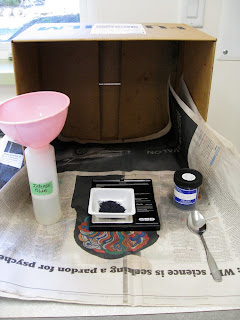This is my new Reliable Velocity iron. I am hoping it has kept the best features of the older model and improved on others.
New on the right. There are a lot more and smaller steam holes. The grooves that shot the steam along the sole plate have gone. It will be hard to compare if the new is more effective but here's hoping.
The top point is pointier - a good feature for detail work but I use this iron mainly for flat yardage. The back is curvier which makes it harder to tell when the straight edge of the fabric is covered with the sole plate.
New on the right. The main difference is the push button digital readout has gone. This was the feature that failed on the older model. My resident engineer says it would have been very difficult to keep the electronics sealed away from the steam chamber. The temperature is now controlled by a manual dial.
The water sprayer has gone. That is OK because I didn't use this feature. The steam-generating chamber produced enough steam to smooth out the driest and most wrinkled fabrics.
The new model has a clearer plastic water chamber so it is easier to see the water level. As a consequence, I don't overfill it as often.
New on the right. The water filter (bottom left on the older model) has gone. With a steam generator, the water quality can affect its lifespan and efficiency. I am filling the new iron with only distilled water to avoid the buildup of scale and rust in the chamber. Even though the shop I bought the first iron from told me it was OK to leave water in the chamber all of the time, I now empty it at the end of each session. It will make a difference in prolonging the life of the iron.
New on the right. The water fillers illustrate the newer model has a smaller water chamber holding about a third less water. I consider this a negative feature because it means I have to refill it more often.
I poured water from the old container into the newer iron and this is the leftover water. I don't know if you can see the water line here.
After a short time using the new iron I found another negative feature. I kept naturally putting my hand forward of the rubber handle and unintentionally pushing the buttons with my palms. I found it was easy to bump the circular dial to a different setting. At first, I thought this heavy iron, which I like the weight of, was unbalanced in that my hand went to the centre point and covered the buttons.
Then I noticed when I kept my hand back away from the buttons my fingers were scrunched against the back of the handle. I have decided the handle design was too short.
I really like that this iron is so heavy. It does a great job without my having to put any weight on the handle. All I need to do is guide it with my hand.
When ironing I aim to keep the iron down and in contact with the cloth as much as possible and to lift it only when I need to move the fabric. By using the weight of the iron and its feature of being able to continuously produce steam I can get a lot of ironing done relatively quickly for little effort on my part. This is the main reason why I bought this brand again. I am hoping its modifications and my better care of it will ensure we have a long and happy life together.
What is your favourite iron? I would be interested to hear from you.




















































